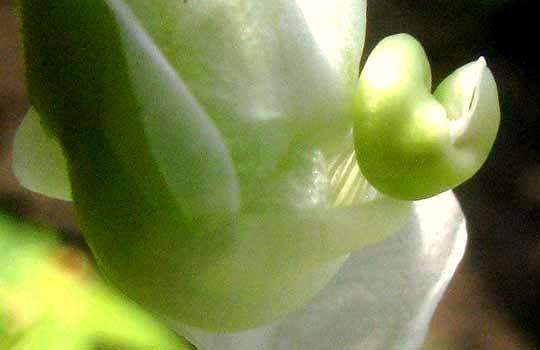Excerpts from Jim Conrad's
Naturalist Newsletter

from the July 14, 2013 Newsletter issued from the Frio Canyon Nature Education Center in the valley of the Dry Frio River in northern Uvalde County, southwestern Texas, on the southern border of the Edwards Plateau; elevation ~1750m (~5750 ft); N29.62°, W99.86°; USA
GREEN BEANS
Each morning I water the gardens beside the red cabin in the valley where I lived this winter, and each morning as sunlight slants in from the east it's a pleasure to see what the various crops are doing. For example, twining up the deer fence around the garden this week you could see what's shown above.
The trifoliate leaves on a vine and the distinctive flowers inform any gardener that this is a green bean vine -- 'Kentucky Wonder,' to be precise. Pods ready to eat on a nearby bush variety can be seen below:

"Green bean" may not be what you call the plant in the picture, but that's what my family taught me to call the plants and their legumes back in rural western Kentucky. However, in other places and in other strata of society they might be called just plain beans, or common beans, string beans, snap beans, field beans, garden beans, haricot beans, pop beans, or something else. They're PHASEOLUS VULGARIS.
Most of the world's major crops originally were developed from wild species in Eurasia, but the ancestral Phaseolus vulgaris was native American, probably from Mexico and Guatemala. The species was introduced into the Old World by the Spaniards and Portuguese, and the bean is still much eaten in Latin America, where about 30% of world production takes place.
The genus to which green beans belong, Phaseolus, is home to about 50 bean species, all native to the Americas. At least three of those other Phaseolus species also have been developed horticulturally, among them the lima bean, Phaseolus limensis.
However, the green bean species, Phaseolus vulgaris, is the big one, and a surprising array of cultivars have been developed from it. The ancestral Phaseolus vulgaris is a vine, but "bush bean" cultivars are derived from it, as are kidney beans, navy beans and wax beans.
The Bean Family, the Fabaceae, is enormous -- by some estimates the third-largest plant family -- incorporating about 730 genera and over 19,400 species. The green bean genus Phaseolus distinguishes itself from its ±730 cogeners with these field marks: "papilionaceous" flowers composed of a top "banner" petal, two side petals called "wings," and two lower petals fused along their common margin to form a scoop-shaped structure, and referred to as the "keel"; leaves of three leaflets, with the middle one on a short stalk; the flowers' styles are "bearded" with hairs at their tips, and; the flowers' keels are coiled or spiraled.
That last field mark is the one to look for, though you may have to dissect a blossom to see it. First, below, take a look at a flower fresh from the plant shown above:

Notice how the side petals (wings) and the down-curved top petal (banner) conceal the two grown-together lower petals (the keel). In the picture just the base of the keel can be seen, curving upward to do its coiling and spiraling hidden from the watching world. Now look at what you see if you bend the wings and banner back, below:

The spiraling keel appears in the picture's top, right corner. At the bottom, left of the spiraling keel you can see several of the ten stamens' slender, anther-bearing filaments rising into the hollow keel.
Why would a flower produce a spiraling keel? In Mexico I asked that question about lima bean flowers, which do something similar. I reported then, "The pollinators I saw landed with their legs grasping the two bottom petals, the wings, so that most of the insect's weight rested on them. As the weight levered the wings down, some kind of inner linkage with the style caused the style's tip to thrust much farther from the keel, thus becoming much more likely to be dusted with pollen."
I suppose that something like that is going on here, but now my eyes are so bad I can't confirm such things.
Whatever the taxonomy, and whatever the story behind green bean's spiraling keels, nothing can take from the pleasure I have each morning when I see my green beans' bright flowers and bounty of bean pods, and the even greater pleasure of tasting the beans in my solar-cooked stews, or suspended inside great, steamy slabs of solar cornbread.